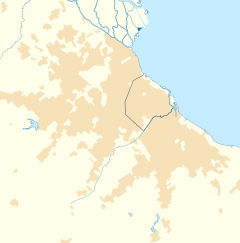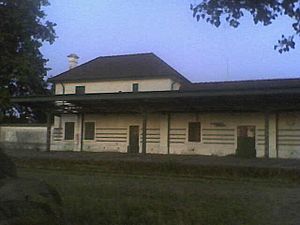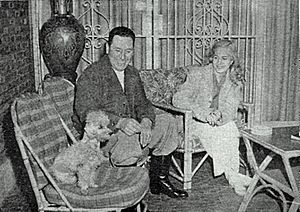San Vicente, Buenos Aires facts for kids
Quick facts for kids
San Vicente
|
|
|---|---|
 |
|
| Country | |
| Province | |
| Partido | San Vicente |
| Founded | 1784 |
| Elevation | 25 m (82 ft) |
| Population
(2001 census [INDEC])
|
|
| • Total | 21,411 |
| CPA Base |
B 1865
|
| Area code(s) | +54 2225 |
| Website | Gobierno Municipal San Vicente |
San Vicente is a town in the Buenos Aires Province of Argentina. It is the main town of the San Vicente Partido (a type of local government area).
San Vicente is the southernmost town in the Greater Buenos Aires area. It is about 48 kilometers (30 miles) from downtown Buenos Aires. You can get there by bus from Constitución Station or by car from Ezeiza International Airport. In 2001, about 21,000 people lived in San Vicente.
Contents
History of San Vicente
San Vicente is named after Saint Vincent Ferrer, a friar from the 1300s. Spanish explorers first settled this area in 1618. It was first called Laguna de la Reducción.
Early Settlement and Growth
In 1696, a landowner named Luis Pessoa y Figueroa bought much of the land around the San Vicente Lagoon. His son, Juan Bautista Pessoa, started a small settlement there in 1734.
A fort called Fortín El Zajón was built by soldiers in 1750. In 1781, Friar Vicente Pessoa, Luis Pessoa's grandson, started the first Catholic church. On December 30, 1784, the county of Magdalena was divided, and San Vicente became one of the new towns.
Becoming a County Seat
In 1822, San Vicente became a county seat. This meant it had one of the province's first Justice of the Peace courts.
Governor Juan José Viamonte started a large farm called La Martiniana in 1824. Many English settlers moved to San Vicente. By 1854, San Vicente was the main place for sheep farming in the province, with over 558,000 sheep.
The area often flooded because of nearby swamps. Authorities suggested moving the town, but the people living there said no. On January 27, 1856, the Municipality of San Vicente was officially created.
Modern Development
The town grew slowly but steadily. In 1896, a tram service began. Growth slowed down during World War I because the market for wool collapsed.
However, in 1928, a new train line connected San Vicente to Buenos Aires. This brought new growth to the town. The Ramón Carrillo Hospital, the town's first hospital, opened in 1949. The local train station closed in 1978 due to budget cuts.
San Vicente has become a "bedroom community." This means many people live there but travel to work in bigger cities. Many famous people from Argentina have lived in San Vicente.
Famous Residents and Attractions
Some well-known people who lived here include:
- Emilie Schindler
- Writer Rodolfo Walsh
- Comics artist Dante Quinterno
- Former Argentina national football team captain Jorge Brown
- Psychiatrist and activist Dr. Alejandro Korn (a nearby town is named after him)
Perhaps the most famous residents were Evita and Juan Perón. They were important leaders in Argentina. They bought a weekend home in San Vicente in 1947. Today, this home is the 17 de Octubre Museum. Juan Perón's remains were moved there in 2006.
Other interesting places to visit in San Vicente include:
- The San Vicente Lagoon and its campgrounds
- The Parish of St. Vincent Ferrer church
- Mariano Moreno Square
- The San Vicente Cultural Museum
See also
 In Spanish: San Vicente (Buenos Aires) para niños
In Spanish: San Vicente (Buenos Aires) para niños





